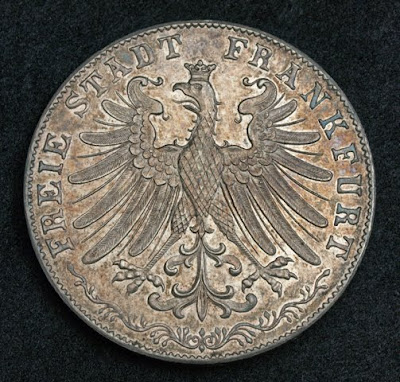 |
| German Commemorative coin Frankfurt Silver 2 Gulden |
 |
| German Coins Frankfurt Silver Double Gulden Coin |
Obverse: Legend in seven lines above anniversary dates of the Peace of Augsburg treaty. All within wreath.
Legend: ZUR DRITTEN SÄCULARFEIER DES RELIGIONS FRIEDENS VOM 25. SEPT. 1555 / 1855
Reverse: Heraldic crowned eagle of Frankfurt looking left.
Legend: FREIE STADT FRANKFURT
Edge Legend: STARK IM RECHT
Mintage: 32,000 pcs
References: KM-353.
Diameter: 36 mm
Weight: 21.2 gram of Silver
German Coins, German coinage, German silver coins, German States Coins, Coins of Germany, German Gold Coins, German commemorative coins, German Imperial Coins, Numismatic Collection, Coins of the German Empire, Coins of Germany best silver coins for investment, silver coins, German East Africa coins, old coins, coin collecting, rare coins, world coins, foreign coins, heritage coins, silver ira investment, silver bullion coins, silver coin collection investors, investment coins, antique coins, Unique Silver Coins, collectible coins, Münzen Deutschland, silbermünzen, Münzen aus Deutschland, Münzen Deutsches Kaiserreich.
After the ill-fated revolution of 1848, Frankfurt was the seat of the first democratically elected German parliament, the Frankfurt Parliament, which met in the Frankfurter Paulskirche (St. Paul's Church) and was opened on 18 May 1848. The institution failed in 1849 when the Prussian king declared that he would not accept "a crown from the gutter". In the year of its existence, the assembly developed a common constitution for a unified Germany, with the Prussian king as its monarch.
Frankfurt lost its independence after the Austro-Prussian War as Prussia in 1866 annexed several smaller states, among them the free city of Frankfurt. The Prussian administration incorporated Frankfurt into its province of Hesse-Nassau. The formerly independent towns of Bornheim and Bockenheim were incorporated in 1890.
Peace of Augsburg
The Peace of Augsburg, also called the Augsburg Settlement, was a treaty between Charles V (Holy Roman Emperor) and the forces of the Schmalkaldic League, an alliance of Lutheran princes, on September 25, 1555, at the imperial city of Augsburg, now in present-day Bavaria, Germany. It officially ended the religious struggle between the two groups and made the legal division of Christendom permanent within the Holy Roman Empire.
The Schmalkaldic League (German: Schmalkaldischer Bund Latin: Foedus Smalcaldicum or Liga Smalcaldica) was a defensive alliance of Lutheran princes within the Holy Roman Empire during the mid-16th century. Although originally started for religious motives soon after the start of the Protestant Reformation, its members eventually intended for the League to replace the Holy Roman Empire as their source of political allegiance. While it was not the first alliance of its kind, unlike previous formations, such as the League of Torgau, the Schmalkaldic League had a substantial military to defend its political and religious interests. It received its name from the town of Schmalkalden, in the German province of Thuringia.